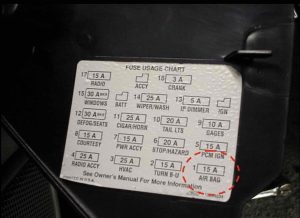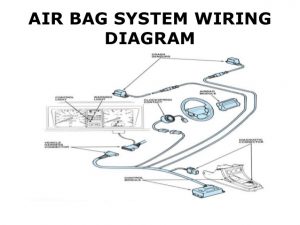Wrongthinkful people are being canceled left and right – mostly by the left – for hurting the feelings of the left. Air bags sometime cancel lives, whether you’re on the left or the right – the risk increasing with age and the deterioration that attends getting older, whether you’re a mechanical thing or an electric thing or a human thing.
Air bags are no different than any other part of your car that wears out eventually. Brake pads don’t last forever, either.
And both can kill you when they wear out, if not attended to.
The difference between brake pads and air bags is that people are led to believe the bags never require maintenance, for the life of the car. This being disingenuous because of the very long lifetime of modern cars, which regularly exceeds 15 years. In fact, more than 50 percent of all cars currently on the road as daily drivers are more than ten years old. Cars 15-plus years old are a commonplace.
And almost all cars made since the mid-late 1990s – which is now 20-plus years ago – have air bags.
The issue of the safety of these aging air bags has never been addressed. Or rather, it has been quietly suppressed – probably because the safety of air bags must be considered absolute.
Air bags are triggered by sensors and rely on wiring/connections to work correctly and after 15 or 20-plus years, as with any electrical or mechanical component, there is the chance of an age-related failure. It’s not likely, but that’s beside the point. You have every right to eliminate the risk, since it is imposed on you – no matter the asserted risk of driving without the air bags being operational.
This risk is well-known to the car companies who were forced by “mandate” to install air bags in every car they made, beginning in the ’90s.
Some car companies – deep in the owner’s manual paperwork – actually recommended replacing the air bags (the entire air bag system, including the sensors) after a certain number of years – typically, about 15 years.
Here’s an interesting article published by the classic car insurance company Hagerty that addresses this business.
From the article – or rather, from the owner’s paperwork published by Mercedes-Benz back in the ’90s:
“Airbags that were installed in Mercedes-Benz passenger vehicles prior to January 1992 have a useful service life of 15 years, and must be replaced after the service life has been reached.”
Italics added.
The article also reassuringly quotes Benz as follows:
“ Airbags installed in Mercedes-Benz passenger vehicles manufactured as of January 1992 no longer have a service life limit, and therefore are not required to be replaced.” 
So they say. But that is saying wires never fray. Connections never work loose. Sensors never fail. Explosive accelerants never deteriorate.
Which is to say . . . bullshit.
Of course, this business – which affects a huge number of getting older every day cars from the ’90s, especially – isn’t much touted by “safety” advocates. Probably because of the outrage that would attend people becoming aware of it and becoming aware of the cost of replacing their aging car’s air bags and peripherals – which is exorbitant and disproportionate relative to the value of a 15-plus-year-old vehicle.
It is quite striking when you reflect on the superciliousness of people – government people, especially – who believe they have the right to impose their notion of acceptable risk and costs on others.
At any rate, you might want to consider eliminating the risk of an aging air bag by cancelling it.
There are generally two methods.
This first is to do what Dave did to the HAL9000 computer in the classic sci-fi movie, 2001: A Space Odyssey. Which is to pull the plug.
By pulling the fuse for its circuit.
This may (probably will) cause the “SRS” – Supplemental Restraint System” light to come on in the dashboard, which may be an issue depending on whether the state you live in requires “safety” inspections to renew vehicle registration. If it does, the light coming on – indicating the air bags aren’t operational – could cause you to fail the test. Of course, the fix is as easy as re-installing the fuse for the duration of the test.
Like putting on a Plague Doctor “mask” to meet the terms and conditions of the “mandate.”
There are also other, more permanent – and subtle – methods, but these involve some work which you’ll need to find a mechanic who is willing to do and who trusts you absolutely to not squeal on him; he could lose his certification from the state to do vehicle inspections/work on cars and possibly more.
I plan to remove the driver’s side air bag in my aging 2002 Nissan pick-up – by removing the entire steering wheel and replacing it with a spare ’70s-era Pontiac Trans-Am three-spoke (and no air bag) “Formula” steering wheel I have laying around.
It will look much better than the ugly factory blob wheel and I will soon be able to “get away” with it when my truck hits 25 years old and becomes eligible for Antique Vehicle plates, which are permanent – no annual registration renewal rigmarole – and no “safety” inspection requirement, either.
An interim solution is to get Farm Use tags, if available in your state. These also eliminate the “safety” inspection requirement – so no worries if the “SRS” light is on because you pulled the fuse.
There are, however, limited use caveats with these two tags.

With Antique tags, you’re technically only permitted to operate the vehicle on public roads to and from car shows and for “maintenance and testing” purposes. If an armed government worker sees you regularly driving the vehicle, he could hassle you. However, it is harder to convict you of anything since it’s hard to prove the Antique-plated vehicle isn’t going to a car show or being driven for “maintenance and testing” purposes. Basically, it’s the AGW’s word against yours – unless the AGW has documented you driving it past his radar trap every day or some such.
I drive my Antique-tagged ’76 Trans-Am often during the warm months and haven’t ever been hassled by an AGW. I think it depends primarily on whether you live in a more – or less – jackbooted area.
Farm Use tags are easier – and harder.
You do not have to wait 25 years – the usual minimum to qualify for Antique tags – but you’re only supposed to operate the vehicle to and from your farm, to get or drop off farm-related stuff like hay or eggs or equipment and so on.
Some states are also tightening up on which kinds of vehicles can qualify for Farm Use Tags, restricting the tags to more plausibly Farm Use trucks and SUVs – which makes it hard if you drive an old Taurus.
It’s also harder to quibble with an AGW who sees you out and about – without any plausible farm-related stuff in the bed and you dressed for work in an office.
Still, you can generally “get away” (isn’t it wonderful how formerly free Americans are forced to use such language to describe going about their business without harming anyone else thereby?) with using Farm tags if you’re reasonably discreet and you live an area where the AGWs are more like the cops that used to exist in America, who had more respect for their profession than to spend their time hassling the people who pay their salaries and who aren’t harming anyone else – as by driving an older car without iffy aging operational air bags that might otherwise harm them.
. . . .
Got a question about cars, Libertarian politics – or anything else? Click on the “ask Eric” link and send ’em in!
If you like what you’ve found here please consider supporting EPautos.
We depend on you to keep the wheels turning!
Our donate button is here.
If you prefer not to use PayPal, our mailing address is:
EPautos
721 Hummingbird Lane SE
Copper Hill, VA 24079
PS: Get an EPautos magnet or sticker or coaster in return for a $20 or more one-time donation or a $10 or more monthly recurring donation. (Please be sure to tell us you want a magnet or sticker or coaster – and also, provide an address, so we know where to mail the thing!)
My eBook about car buying (new and used) is also available for your favorite price – free! Click here. If that fails, email me at EPeters952@yahoo.com and I will send you a copy directly!














The only Vehicle I ever owned with an Air Bag (Driver’s only) was a 94 Dodge Ram Diesel (Cummins 12-Valve Mechanical Injection) and after 5 Years in service, I took it to the Dealer (for the first time ever) and said,
“Replace the Airbag”. The argument that ensued was Entertaining, until I told them that as a Jet Mechanic (at the time with only 15 Years of Experience) I would NEVER let a Pyrotechnic Actuator go more than 2 Years (most are only good for 1) and the Airbag was at 5.
Now, on Jets, “Pyros” are used on the most Critical Safety Systems, like Engine Fire Extinguishers, Ejection Seats, and Escape Hatches, things that MUST WORK even if the Electrical System is Shorted and on Fire, meaning that they can be Activated by as little as 1 Volt and a few Milliamps of Current. I don’t Know what Automotive Pryos are rated at for Ignition, but the lack of a “Life Limit” to these Items is Unacceptable…
Exactly, Gryphon –
Everything wears out. This idea that air bags and critical peripherals “last forever” or never need maintenance is akin to “lifetime coolant” and so on. Sure – if “lifetime” means a fixed number of years (which it does; read the fine print the car manufacturers publish with their service schedules) rather than indefinitely.
The difference here being that never changing the coolant only risks ruining the cooling system while aging SRS systems risks your life.
My state (WA) does issue farm plates, but ONLY to a registered FARM, and it can ONLY be used wihtin 25 miles of the dirt. Not too handy. They will also issue collector car plates, but before one can do that they MUST have a different vehicle with normal series plates. Fine, it only has to be currently plated, does NOT have to be insured. Find some old beater that does not even run and get standard number plates for thent, then leave it parked in the yard. BUT< by the time any car is 25 years old, it likely won't have much resale value anyway. Still saves on the regular plate costs, as it is non-expiring. Have not looked into insurance.
My old ford van has 375K on it costs near a buck and half peryear for plates, and only needs to survive another threee years to qualify for collector plates.
As to the airbags.. mine was parked some time ago and someone else's car parked up the hill, and did NOT fully engage park… it rolled down the hill and dealt a hard blow to the front end of mine. Their insurance bought the van for decent market value, then the eedjits sold it bck to me for $200. I spent an afternoon removing the front end plastic and tin, yanked the crossbar for the radiator support straight again, =pulled all the stuff out of the cooling fan, remounted it to the now more or less straight crossbar, rahung all the rest of the junk and made it drivable again.
the air bag inertia switch rides behind the plastic grille, and forward of the aluminium AC condensor, just above the bumper level. That thing got smacked hard in the prang. I observed the airbag idiot lamp lit, it has been ever since. It begins its cycle by flashing slowly, then moves to a rapid flash, as soon as the vehicle travels more than a couple hudnred feet. After a short while it simply turns itself off. Since mine was parked key off not running, the airbags did not blow in the prang.
I have NO INTENTION of replaceing that when I finally come round to rwpairing the front end cosmetics. Im fine with =out them. I know the centrifugal clutches on the safety belt work just fine.
This car is the newest one I've ever owned, by about ten years, and its a 98. Still rins like it did when I bought it nineteen years ago with only 130 K on the clock.
Hi T,
I expect the creeps to “lock down” these “loopholes” – e.g., the Farm Use and Antique tags – in time but for now they are still viable, thankfully. I always take good care of my vehicles and so my ’02 still looks very presentable and is in excellent mechanical condition. It should remain so for at least another decade and during that decade I will probably begin to pre-emptively prepare it for the next ten (or 20) years…as by getting it painted and any body work it needs done, etc.
The few new vehicles that appeal to me because of performance or some such metric terrify me because of their preposterous cost, titanic depreciation, exorbitant cost to insure and fix and their Big Brothery “connectedness.”
I never thought about this. I plan to keep my car for at least 15 years, it’s already 3.5 years old. I would expect that by that time, the cost to replace the air bags and sensors would essentially “total” the vehicle. Of course, by 2030, there will be no more gas vehicles anyway…only fake EV’s. There will be no place to go because everything will closed or blown away in the wind. Most jobs will be gone or work-at-home only. There will be only a few GIANT super sized companies providing everything you need, and they will deliver it. The Commie triumvirate of Schwab, Gates and Soros have a marvelous future planned for us…that is for the remaining 500 million who might still be alive. Few are going to survive the coming multitude of RNA/DNA scrambling gene therapies designed solely to protect you from LIVING a long life and wrecking Billy’s planet.
One thing that sucks about airbag equipped cars is that their seat belts are designed to deposit you into the airbag, not to keep you from hitting the dashboard. Cars in the 90’s still had real seat belts since airbags were often optional, or were added to cars designed for seat belts as their only restraint system, but over time, as safety mandates ramped up, seat belts and airbags are two complementary systems, neither of which is now safe without the other.
Yes, the airbag thing on a 15+ year old car is a problem. I had a 97 Merc Mountaineer and live in PRoVA, so am subject to the yearly Virginia inspection. With my old cars, typically I would go over it, then have my mechanic go over/fix anything, then take it to the Inspector. Dammit, if the f$#&ing airbag light didn’t go on along my way to the Inspection! Turns out it was a sensor up inside the front bumper for the system. So, $650 later I get the damn sticker.
Farm Use tags are a decent workaround if you live in the country and the said vehicle is solely a chore truck. The penalty is pretty stiff for fraudulent use. However, Tractor Supply, Rural King and Southern States stock a lot of stuff for your entire household and the cops probably don’t canvass those stores too hard. Wal-Mart, Target, etc. likely different. Strictly, you cant even swing by the Drive Thru to get lunch on your way back to your “farm”. What is rich, pun intended, is when I see these on new F350 dually King Ranch diesels ($80k vehicles).
Antique tags are the better than farm tags. Allow for a lot more flexibility in driving around. YMMV
A quick question: is there a chance that you’ll be on Gab anytime soon? Asking for a friend.
Hi Ralph,
I’m on Gab! Search “EPautos”… https://gab.com/EPautos
Excellent! Sometimes it’s hard to tell what name to look under. Following. Thanks!
Thanks, Ralph!
Just recently someone stole the catalytic converter off my car. Probably a “non-essential” trying to survive. Or maybe an addict supporting their habit. Anyway, I’ve just been driving it around with a straight pipe off the manifold. I won’t pay for a replacement because it’ll just get stolen again. I expect the AGWs will harass me about it eventually. When they do I’ll try to find someone willing to put a straight pipe on it. Gotta love the world the geniuses in charge have created in order to keep us safe from the covid.
You can use “spark plug anti-foulers” to provide additional space between the exhaust stream and the O2 sensor. “These spark plug anti-foulers” have the same thread size as O2 sensors and can help make the “check engine” light remain off.
interestingly, it is the older air bag systems that are probably still functional and safe. Since the consumer was taken out of the equation when these things were mandated, the industry took the cheaper route, hence the problems with the ammonium nitrate inflators becoming bombs. If one has bags using airbag propellant Tetrazole, they are probably just fine as this compound was the engineer’s dream for its long lasting stability. Even the earlier propellant sodium azide is probably just fine.
I see a hobby industry or DIY where people figure out how to de mil their airbags while keeping things looking correct.
I’m far more concerned over the condition of my ball-bag than that of my air-bag.
this is not spam…
THIS INFORMATION IS FOR STUDY PURPOSES ONLY. DO NOT ATTEMPT TO DO THIS UNLESS YOU ARE QUALIFIED TO DO SO.
Airbag disconnection is technically illegal under federal law but it can be done easily and safely.
You will need tools to disassemble the steering wheel and will also need a volt-ohm meter. Additional parts needed will be a 100K potentiometer, used to determine the resistance value needed to turn off the airbag light. Connect the center and one of the side lugs on the potentiometer to the airbag vehicle connector, NOT to the airbag connector itself.
1. Disconnect the vehicle battery and wait 15 minutes for the airbag circuit capacitors to discharge.
2. Remove the airbag from the steering wheel and unplug the airbag connector.
3. Reconnect the vehicle battery and connect the potentiometer to the vehicle airbag connector.
4. Rotate the potentiometer shaft until the airbag light goes out.
5. Disconnect the potentiometer from the airbag circuit.
6. Using the volt-ohm meter, measure the resistance of the potentiometer center and side lug.
7. Obtain a fixed-value resistor of the same resistance value (ohms) and attach it to the connector.
8. Reinstall the airbag without plugging in the connector.
IMPORTANT! DO NOT ATTEMPT TO MEASURE THE RESISTANCE OF THE AIRBAG DIRECTLY. IT WILL DEPLOY IF YOU USE THE VOLT-OHM METER TO ATTEMPT TO MEASURE AIRBAG RESISTANCE DIRECTLY.
Airbag manufacturers of course have a specification for acceptance resistance range … which they probably don’t deign to share with the public.
Nevertheless, various aftermarket sources offer 2 ohm resistors (claimed to be universal) to bypass airbags.
https://www.driftshop.com/airbag-canceller.html
Two ohms seems low. At 12 volts, it implies a constant 6-amp current drain. Do airbags really suck that much power all the time? If a 4 or 5 ohm resistor successfully cancels the SRS light, it would reduce the parasitic electrical load.
The actual resistance that most airbags use is 3 ohms. There are test tools that plug in place of an airbag igniter that can be used to eliminate everything else in the circuit from causing your fault. The actual voltage that the airbag module uses for testing is very small, somewhere in the milavolt range. If it applied 12 volts the airbag will deploy.
That would give you a hell of a wake up if you did…
Pretty-much what I did when I replaced the factory Air Bag seats in my Audi with Recaros.
Oh great! That bit of info into the wrong ears (busy body “advocates”, politicians, etc.) would use it to force old autos off the road. Using the “safety” loophole would mandate the airbag replacement to remain legal. The high cost of replacement vs car value would force them into the scrapyard. Not to mention the average person does not have that kind of disposable income to pay for it. I’m hoping some A-hole with the DOT doesn’t see this!
There comes a time when the use of my very favorite word becomes required. NO! The instant any armed goon pretends he is going to force me to abandon my perfectly serviceable vehicle because of a system the very same goons with guns required me to buy, will be just another of a growing list of things up with which I will not put. Give me liberty or give me death isn’t a political slogan. It’s a statement of fundamental philosophy. I will not live on my knees. I won’t beg for what is rightfully mine already, like keeping my car on the road.
Having a 2000 Chevy C3500, I have no airbags! I too am coming up to that antique status. I hope to keep my truck as long as I am on this side of pushing up Canadian Thistle…